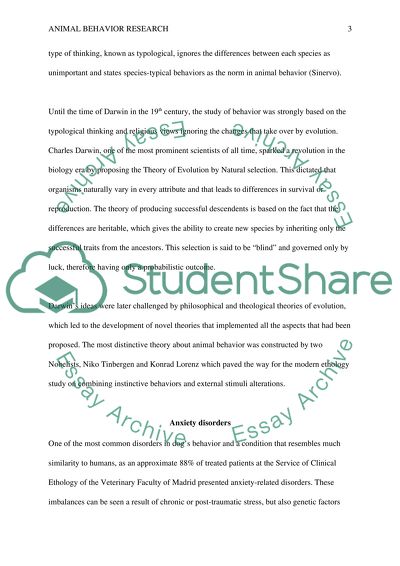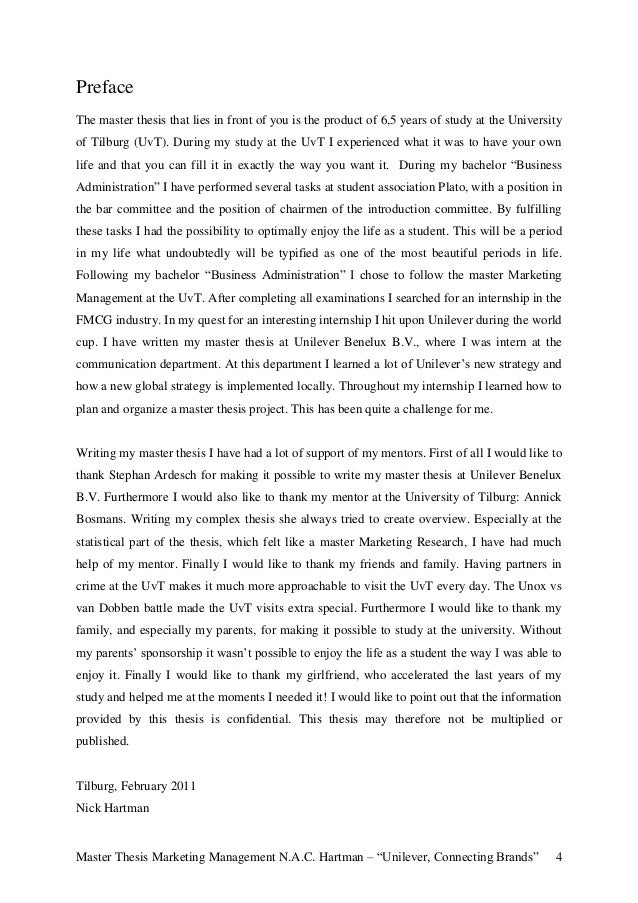
A thesis, or dissertation (abbreviated diss.), is a document submitted in support of candidature for an academic degree or professional qualification presenting the author's research and findings. In some contexts, the word "thesis" or a cognate is used for part of a bachelor's or master's course, while "dissertation" is normally applied to a doctorate.. This is the typical arrangement in Analysts consider this “normal” behavior. • Around the titles of an article or chapter if you mention that title in the text of your paper: Wolf’s () article, “Social Validity: The Case for Subjective Measurement or How Applied Behavior Analysis is Finding its Heart” identified Apr 29, · Opening the discussion of EBP in this journal, Smith (The Behavior Analyst, 36, 7–33, ) raised several key issues related to EBP and applied behavior analysis (ABA). The purpose of this paper is to respond to Smith’s arguments and extend the discussion of the relevant issues
Thesis - Wikipedia
Try out PMC Labs and tell us what you think. Learn More. This framework provides behavior analysts with a structure for pervasive use of the best available evidence in the complex settings in which they work. This structure recognizes the need for clear and explicit understanding of the strength of evidence supporting writing term paper in applied behavior options, the important contextual factors including client values that contribute to decision making, and the key role of clinical expertise in the conceptualization, intervention, and evaluation of cases.
Opening the discussion of EBP in this journal, Smith The Behavior Analyst, 367—33, raised several key issues related to EBP and applied behavior analysis ABA. We offer a definition and framework for EBP that aligns with the foundations of ABA and is consistent with well-established definitions of EBP in medicine, psychology, and other professions. In addition to supporting the systematic use of research evidence in behavior analytic decision making, this definition can promote clear communication about treatment decisions across disciplines and with important outside institutions such as insurance companies and granting agencies.
Almost 45 years ago, Baer et al. This discipline was distinguished from the experimental analysis of behavior by its focus on social impact i. ABA has produced remarkably powerful interventions in fields such as education, developmental disabilities and autism, clinical psychology, behavioral medicine, organizational behavior management, and a host of other fields and populations. Behavior analysts have long recognized that developing interventions capable of improving client behavior solves only one part of the problem.
The problem of broad social impact must be solved by having interventions implemented effectively in socially important settings and at scales of social importance Baer et al. This latter set of challenges has proved to be more difficult. In many cases, demonstrations of effectiveness are not sufficient to produce broad adoption and careful implementation of writing term paper in applied behavior procedures. Key decision makers may be more influenced by variables other than the increases and decreases in the behaviors of our clients.
In addition, even when client behavior is a very powerful factor in decision making, it does not guarantee that empirical data will be the basis for treatment selection; anecdotes, appeals to philosophy, or marketing have been given priority over evidence of outcomes Carnine ; Polsgrove Across settings in which behavior analysts work, there has been a persistent gap between what is known from research and what is actually implemented in practice.
Behavior analysts have been concerned with the failed adoption of research-based practices for years Baer et al. Even in the fields in which behavior analysts have produced powerful interventions, the vast majority of current practice fails to take advantage of them. Behavior analysts have not been alone in recognizing serious problems with the quality of interventions used employed in practice settings. In the s, many within the medical field recognized a serious research-to-practice gap.
This raised the troubling question of what basis was used for the remaining decisions if it was not high-quality evidence. These concerns led to the development of evidence-based practice EBP of medicine Goodman ; Sackett et al. The research-to-practice gap appears to be universal across professions, writing term paper in applied behavior.
In recognition of their own research-to-practice gaps, numerous professions have adopted an EBP framework. Nursing and other areas of health care, social work, clinical and educational psychology, speech and language pathology, writing term paper in applied behavior, and many others have adopted this framework and adapted it to the specific needs of their discipline to help guide decision-making.
Not only have EBP frameworks been helping to structure professional practice, but they have also been used to guide federal policy. With the passage of No Child Left Behind and the reauthorization of the Individuals with Disabilities Education Improvement Actthe federal department of education has aligned itself with the EBP movement.
A recent memorandum from the federal Office of Management and Budget instructed agencies to consider evidence of effectiveness when awarding funds, writing term paper in applied behavior, increase the use of evidence in competitions, and to encourage widespread program evaluation Zients Where evidence is suggestive, writing term paper in applied behavior, we should consider it. EBP is more broadly an effort to improve decision-making in applied settings by explicitly articulating the central role of evidence in these decisions and thereby improving outcomes.
It addresses one of the long-standing challenges for ABA; the need to effectively support and disseminate interventions in the larger social systems in which our work is embedded.
In particular, EBP addresses the fact that many decision-makers are not sufficiently influenced by the best evidence that is relevant to important decisions. Given that the EBP framework is well established in many disciplines closely related to ABA writing term paper in applied behavior in the larger institutional contexts in which we operate e. Discussion of issues related to EBP in ABA has taken place across several years. Researchers have extensively discussed methods for identifying well-supported treatments e.
However, until recently, discussion of an explicit definition of EBP in ABA has been limited to conference papers e. Smith opened a discussion of the definition and critical features of EBP of ABA in the pages of The Behavior Analyst.
In his thought-provoking article, Smith raised many important points that deserve serious discussion as the field moves toward a clear vision of EBP of ABA. Most importantly, Smith argued that behavior writing term paper in applied behavior must carefully consider how EBP is to be defined and understood by researchers and practitioners of behavior analysis.
However, we have a core disagreement with Smith concerning the vision of what EBP is and how it might enhance and expand the effective practice of ABA. As behavior analysts know, definitions matter. A well-conceived definition can promote conceptual understanding and set the context for effective action. Conversely, a poor definition or confusion about definitions hinders clear understanding, communication, and action. In providing a basis for his definition of EBP, Smith refers to definitions in professions that have well-developed conceptions of EBP.
He quotes the American Psychological Association APA definition which we quote here more extensively than he did :, writing term paper in applied behavior.
Evidence-based practice in psychology EBPP is the integration of the best available research with clinical expertise in the context of patient characteristics, culture, and preferences. This definition of EBPP closely parallels the definition of evidence-based practice adopted by the Institute of Medicinep.
The key to understanding this definition is to note how APA and the Institute of Medicine use the word practice. This is the sense in which one might speak of the professional practice of behavior analysis. American Psychological Association Presidential Task Force of Evidence-Based Practice further elaborates this point:. It is important to clarify the relation between EBPP and empirically supported treatments ESTs ….
ESTs are specific psychological treatments that have been shown to be efficacious in controlled clinical trials, whereas EBPP encompasses a broader range of clinical activities e. As such, EBPP articulates a decision-making process for integrating multiple streams of research evidence—including but not limited to RCTs—into the intervention process. In contrast, Smith defined EBP not as a decision-making process but as a set of interventions that have been shown to be efficacious through rigorous research.
He stated:. Thus it is likely to be an integrated package of procedures, operationalized in a manual, writing term paper in applied behavior, writing term paper in applied behavior validated in studies of socially meaningful outcomes, usually with group designs.
This is a common misconception found in conversation and in published articles e, writing term paper in applied behavior. Before entering into the discussion of a useful definition of EBP of ABA, we should clarify the functions that we believe a useful definition of EBP should perform. First, a useful definition should align with the philosophical tenets of ABA, support the most effective current practice of ABA, and contribute to further improvement of ABA practice.
A definition that is in conflict with the foundations of ABA or detracts from effective practice clearly would be counterproductive. Second, a useful definition of EBP of ABA should enhance social support for ABA practice by describing its empirical basis and decision-making processes in a way that is understandable to professions that already have well-established definitions of EBP. A definition that corresponds with the fundamental components of EBP in other fields would promote ABA practice by improving communication with external audiences.
This improved communication is critical in the interdisciplinary contexts in which behavior analysts often practice and for legitimacy among those familiar with EBP who often control local contingencies e. Based on these functions, we propose the following definition: Evidence-based practice of applied behavior analysis is a decision-making process that integrates a the best available evidence with b clinical expertise and c client values and context.
This definition positions EBP as a pervasive feature of all professional decision-making by a behavior analyst with respect to client services; it is not limited to a narrowly restricted set of situations or decisions.
The definition asserts that the best available evidence should be a primary influence on all decision-making related to services for clients e. It also recognizes that evidence cannot be the sole basis for a decision; effective decision-making in a discipline as complex as ABA requires clinical expertise in identifying, defining, and analyzing problems, determining what evidence is relevant, and deciding how it should be applied. In the absence of this decision-making framework, practitioners of ABA would be conceptualized as behavioral technicians rather than analysts.
Further, the definition of EBP of ABA includes client values and context. Decision-making is necessarily based on a set of values that determine the goals that are to be pursued and the means that are appropriate to achieve them. Context is included in recognition of the fact that the effectiveness of an intervention is highly dependent upon the context in which it is implemented. The definition asserts that effective decision-making must be informed by important contextual factors.
We elaborate on each component of the definition below, but first we contrast our definition with that offered by Smith Although Smith made brief reference to the other critical components of EBP, he framed EBP as a list of multicomponent interventions that can claim a sufficient level of research support. We agree with his argument that such lists are valuable resources for practitioners and therefore developing them should be a goal of researchers.
However, such lists are not, by themselvesa powerful means of improving the effectiveness of behavior analytic practice. The vast majority of decisions faced in the practice of behavior analysis cannot be made by implementing the kind of manualized, multicomponent treatment packages described by Smith. There are a number of reasons a list of interventions is not an adequate basis for EBP of ABA. Thus, although the example referenced the autism treatment literature, it seems apparent that even a loose interpretation of this particular criterion would leave all practitioners with a highly restricted number of intervention options.
This flexibility is necessary to meet the diverse needs of their clients and to minimize the response demands on direct care providers or staff, who are less likely to implement a complicated intervention with fidelity Riley-Tillman and Chafouleas With the list approach to defining EBP, research only impacts writing term paper in applied behavior by placing an intervention on a list when a specific criteria has been met.
Similarly, a research study that shows clear results but is not part of a sufficient body of support for an intervention would also have no influence. A study that provides suggestive results but is not methodologically strong enough to be definitive would have no influence, even if writing term paper in applied behavior were the only study that is relevant to a given problem.
The primary problem with a list approach is that it does not provide a strong framework that directs practitioners to include the best available evidence in all of their professional decision-making. In contrast, writing term paper in applied behavior, definitions of EBP as a decision-making process can provide writing term paper in applied behavior robust framework for including research evidence along with clinical expertise and client values and context in the practice of behavior analysis.
In the next sections, we explore the components of this definition in more detail. The Behavior Analyst Certification Board Guidelines for Responsible Conduct for Behavior Analysts repeatedly affirm ways in which behavior analysts should base their professional conduct on the best available evidence.
For example:. Behavior analysts rely on scientifically and professionally derived knowledge when making scientific or professional judgments in human service provision, or when engaging in scholarly or professional endeavors. The behavior analyst always has the responsibility to recommend scientifically supported most effective treatment procedures. Effective treatment procedures have been validated as having both long-term and short-term benefits to clients and society.
Clients writing term paper in applied behavior a right to effective treatment i, writing term paper in applied behavior. The term best implies that evidence can be of varying quality, and that better quality evidence is preferred over lower quality evidence. Quality of evidence for informing a specific practical question involves two dimensions: a relevance of the evidence and b certainty of the evidence, writing term paper in applied behavior.
The dimension of relevance recognizes that some evidence is more germane to a particular decision than is other evidence. This idea is similar to the concept of external validity. External validity refers to the degree to which research results apply to a range of applied situations whereas relevance refers to the degree to which research results apply to a specific applied situation.
In general, evidence is more relevant when it matches the particular situation in terms of a important characteristics of the clients, b specific treatments or interventions under consideration, c outcomes or target behaviors including their functions, and d contextual variables such as the physical and social environment, staff skills, and the capacity of the organization.
How to Write a Research Methodology in 4 Steps - Scribbr ��
, time: 4:54
Analysts consider this “normal” behavior. • Around the titles of an article or chapter if you mention that title in the text of your paper: Wolf’s () article, “Social Validity: The Case for Subjective Measurement or How Applied Behavior Analysis is Finding its Heart” identified Apr 29, · Opening the discussion of EBP in this journal, Smith (The Behavior Analyst, 36, 7–33, ) raised several key issues related to EBP and applied behavior analysis (ABA). The purpose of this paper is to respond to Smith’s arguments and extend the discussion of the relevant issues A thesis, or dissertation (abbreviated diss.), is a document submitted in support of candidature for an academic degree or professional qualification presenting the author's research and findings. In some contexts, the word "thesis" or a cognate is used for part of a bachelor's or master's course, while "dissertation" is normally applied to a doctorate.. This is the typical arrangement in

No comments:
Post a Comment